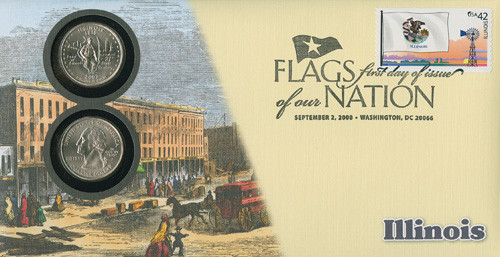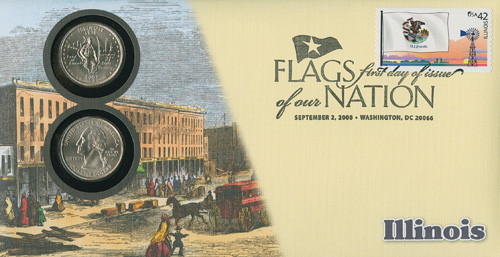
# CNC30 FDC - 2008 42c Flags of Nation, IL coin FDC
2008 42¢ Flags of Our Nation
This Flags of Our Nation Coin Cover features the Illinois stamp from the Flags of Our Nation Series, two uncirculated state quarters, and a cachet, or picture, that reflects the history of the state.
Young Abraham Lincoln moved in 1830 to an Illinois farm with his family, which had been lured by the state’s rich black soil. With over 600 different types of soil, the state is today a leader in agricultural production, especially corn and soybeans.
When the Black Hawk War began, Lincoln enlisted in the Illinois Militia, and was chosen the company’s captain. Admitting he hadn’t fought any Indians, Lincoln later told the House of Representatives he “had a good many bloody struggles with the mosquitoes...” Abraham Lincoln (1809-1865) former Illinois State Representative and U.S. President is featured on the Illinois State Quarter.
Chicago, largest city in Illinois, rises from the shores of Lake Michigan with several of the country’s tallest skyscrapers. At 108 stories, the Sears Tower is the highest point in the state and the tallest building in the Western Hemisphere. Chicago’s Randolf Street in the 1850s is shown on the historic woodcut cachet. By 1890, the skyline had changed dramatically. The railroad transformed Chicago from a small, frontier outpost to a city of over a million people, the second largest in the United States.
Modern American farm windmills, like the one shown on the Illinois State Flag stamp, are used on the prairie to pump water to farms. Older, Dutch-style windmills were once a fairly common sight in Illinois, but today only a few remain.
2008 42¢ Flags of Our Nation
This Flags of Our Nation Coin Cover features the Illinois stamp from the Flags of Our Nation Series, two uncirculated state quarters, and a cachet, or picture, that reflects the history of the state.
Young Abraham Lincoln moved in 1830 to an Illinois farm with his family, which had been lured by the state’s rich black soil. With over 600 different types of soil, the state is today a leader in agricultural production, especially corn and soybeans.
When the Black Hawk War began, Lincoln enlisted in the Illinois Militia, and was chosen the company’s captain. Admitting he hadn’t fought any Indians, Lincoln later told the House of Representatives he “had a good many bloody struggles with the mosquitoes...” Abraham Lincoln (1809-1865) former Illinois State Representative and U.S. President is featured on the Illinois State Quarter.
Chicago, largest city in Illinois, rises from the shores of Lake Michigan with several of the country’s tallest skyscrapers. At 108 stories, the Sears Tower is the highest point in the state and the tallest building in the Western Hemisphere. Chicago’s Randolf Street in the 1850s is shown on the historic woodcut cachet. By 1890, the skyline had changed dramatically. The railroad transformed Chicago from a small, frontier outpost to a city of over a million people, the second largest in the United States.
Modern American farm windmills, like the one shown on the Illinois State Flag stamp, are used on the prairie to pump water to farms. Older, Dutch-style windmills were once a fairly common sight in Illinois, but today only a few remain.




























